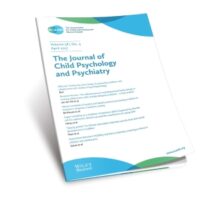Magnetic Resonance Imaging (MRI & fMRI)
-

A network approach to the investigation of childhood irritability: probing frustration using social stimuli
Paper from the JCPP – ‘Currently, there is inconsistency in the identification of neural circuits that underlie irritability in children, especially in social contexts. This study aimed to address this gap by utilizing a functional magnetic resonance imaging (fMRI) paradigm to investigate pediatric anger/frustration using social stimuli.’ Khalil I. Thompson et al.
Read more -

Children with maltreatment exposure exhibit rumination-like spontaneous thought patterns: association with symptoms of depression, subcallosal cingulate cortex thickness, and cortisol levels
Open Access paper from the JCPP – ‘We studied the impact of maltreatment on self-generated thought (SGT) patterns and their association with depressive symptoms, subcallosal cingulate cortex (SCC) thickness, and cortisol levels in children.’ Ferdinand Hoffmann et al.
Read more -

Is frontoamygdalar connectivity in the resting brain linked with externalising behaviours during development?
Externalising problems tend to vary over the course of development, but often peak in late adolescence. Data suggest that the frontoamygdalar brain circuitry (involved in emotion regulation) might have an important role in mediating externalising behaviour.
Read more -

Mothers’ prenatal BMI is linked with foetal brain connectivity
New data suggest that a high maternal prenatal body mass index (BMI) is associated with differences in functional connectivity in the foetal brain that might confer a risk of mental health and cognitive problems in childhood.
Read more -

Is brain circuitry linked with early symptoms of autism spectrum disorder?
Researchers in San Diego, USA, have studied the relationship between brain network connectivity and emerging autism spectrum disorder (ASD) symptoms in toddlers aged 17-45 months with (n=24) or without (n=23) ASD.
Read more -

In Conversation… Assistant Professor Dr. Dienke Bos on Neuroimaging
Dr. Bos looks at the typical development of behavioural control and how this is represented naturally, magnetic resonance imaging to monitor brain changes in relation to childhood development, and where the evidence is that early intervention can slow or reverse damage. Includes transcription, and links.
Read more -

Cortical thickness can differentiate conduct disorder subtypes
A study by Graeme Fairchild and colleagues has used a neuroimaging approach to compare the structural organization (or “covariance”) of brain regions between youths with different subtypes of conduct disorder (CD) and healthy controls (HC).
Read more -

Most Cited JCPP Articles #54 of 60
Most cited JCPP papers #54 of 60: Brain basis of early parent–infant interactions: psychology, physiology, and in vivo functional neuroimaging studies
Read more -

Accelerated cortical thinning correlates with early signs of depression
The brain undergoes structural changes as it develops over childhood, but whether abnormal structural changes are associated with emerging depressive symptoms in adolescence is unknown. Now, a longitudinal study that enrolled 205 participants aged 8-25 years without signs of depression has used magnetic resonance imaging (MRI) to monitor these brain changes over adolescence.
Read more -

Targeting the neural task-control circuitry to enhance self-regulatory control in bulimia nervosa
Previous research has found that bulimia nervosa is associated with dysregulated self-regulatory control, as a result of anatomical and functional disturbances to the neural task-control circuitry in the brain.
Read more